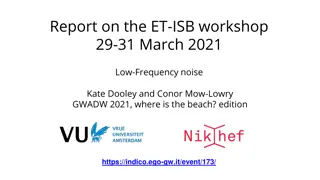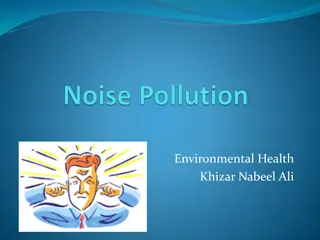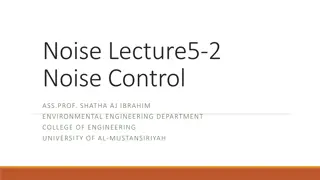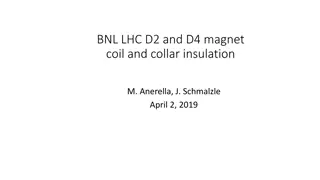Sound Insulation Techniques in Noise Pollution Control
Sound insulation is crucial in reducing airborne and structure-borne noise transmission. Techniques such as using partitions, composite partitions, mass, and absorbents help in attenuating sound energy and improving acoustic comfort in buildings. Understanding transmission coefficients, sound absorption, and mass considerations are essential for effective noise control strategies.
Download Presentation

Please find below an Image/Link to download the presentation.
The content on the website is provided AS IS for your information and personal use only. It may not be sold, licensed, or shared on other websites without obtaining consent from the author.If you encounter any issues during the download, it is possible that the publisher has removed the file from their server.
You are allowed to download the files provided on this website for personal or commercial use, subject to the condition that they are used lawfully. All files are the property of their respective owners.
The content on the website is provided AS IS for your information and personal use only. It may not be sold, licensed, or shared on other websites without obtaining consent from the author.
E N D
Presentation Transcript
Lec.4 Noise Pollution 4thyear Sound Insulation Airborne Sound: Sound or noise radiated directly from a source, such as a loudspeaker or machine, into the surrounding air. Structure-borne Sound: Sound which reaches the receiver after travelling from the source via a building or machine structure; structure-borne sound travels very efficiently in building and is more difficult to predict than airborne sound. Sound Insulation: The reduction or attenuation of airborne sound by a solid partition between source and receiver; this may be a building partition (e.g. a floor, wall or ceiling), a screen or barrier or an acoustic enclosure. 1
4.1 Sound insulation by partitions Sound can be transmitted into a room by some or all of the methods shown in Figure below 1. Airborne sound in the source room excites the separating partition into vibration which directly radiates the sound into the receiving room. The amount of attenuation will depend upon the frequency of sound, the mass, fixing conditions and thus the resonant frequencies of the partition. 2. Airborne sound in the source room may excite walls other than the separating one into vibration. The energy is then transmitted through the structure and re-radiated by some other partition into the receiving room. 3. Any wall other than the separating one may be excited. The sound is transmitted to the separating wall and the re- radiated by it. 4. Sound energy from the separating partition is radiated into the receiving room by some other wall. (2) (3) Source Room (1) Receiving Room (4) 2
4.2 Sound insulation by composite partitions The sound reduction of a partition measured in dB will depend upon the proportion of sound energy transmitted. Reduction in dB = 10log1 t Where t= is the transmission coefficient (the ratio of sound energy transmitted by a partition, or across a boundary, to 1 the sound energy incident upon the partition or the boundary, ? = 2 ?? 2?? where = angular frequency (radians/sec) = 2 f m= mass of the partition /unit area When calculating the sound insulation of a partition consisting of more than one part ( e.g. a 115 mm brick wall with a door) it is first necessary to find the transmission coefficient of each. From this, the average transmission coefficient may be calculated using this formula: tav S= t1 S1+ t2 S2+ .. where tav=average transmission coefficient S= total area of the partition, m2 t1 , t2, .= transmission coefficients of each section. S1 , S2, = area of each part, m2 3
4.3 The sound insulation depend on mass The insulation from a single partition is approximately Rav= 10+14.5 log m Where Rav= average sound reduction in dB m = mass/ unit area in kg/m2 4.4 The sound insulation using absorbents Sound absorption: 1) the process whereby sound energy is converted into heat, leading to a reduction in sound pressure level. 2) the property of a material which allows it to absorb sound energy like the porous materials Sound absorption coefficient: a measure of the effectiveness of material as sound absorbers, it is the ratio of the sound energy absorbed or transmitted (not reflected) by a surface to the total sound energy incident upon that surface, the value of the coefficient varies from 0 (for very poor absorbers and good reflectors) to 1 (for very good absorbers and poor reflectors). 4
Reverberation time: the time required for the steady sound pressure level in an enclosed space to decay by 60dB, measured from the moment the sound source is switched off. The table below indicates mean sound absorption coefficient - m- and reverberation time - t - for some typical rooms. The mean sound absorption coefficient should be calculated when more accurate values are needed. Room Characteristics Very Soft Soft Normal Hard Very Hard Reverberation time - t- 0.2 < t < 0.25 0.4 < t < 0.5 0.9 < t < 1.1 1.8 < t < 2.2 2.5 < t < 4.5 Restaurant Theater Lecture hall Office Library Flat Hospital Church Large church Factory Typical Room Radio and TV studio Mean sound absorption coefficient - m- 0.40 0.25 0.15 0.10 0.05 5
Sabines formula: t =0.16 V , where V= volume of room in m3, A= absorption area in m2 A the improvement that can be achieved by the use of absorbent materials in dB= 10 log (A+a)/A where A= number of m2 of absorption originally and equal S m a= number of m2 of absorption added 4.5 Attenuation in ducts Noise from ventilator fans or from other rooms can easily be transmitted by means of ducts. By lining the duct with absorbent attenuation per meter, R1, is obtained, given approximately by: ? ? 1.4 ?1= Where P = perimeter of the duct in m S= cross-sectional area in m2 = absorption coefficient 6
4.6 Grill attenuation Reduction of sound at the opening in dependent upon the area of the grille and the total sound absorption within the room. ? ? ?2= 10log where A= absorption area in m2 S= cross-sectional area of the grill in m2 7























